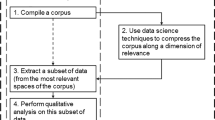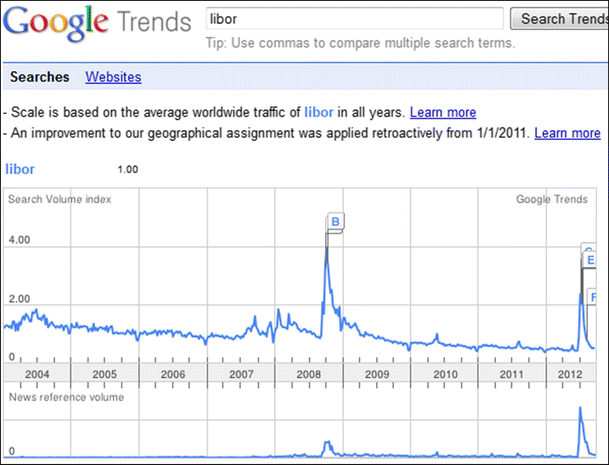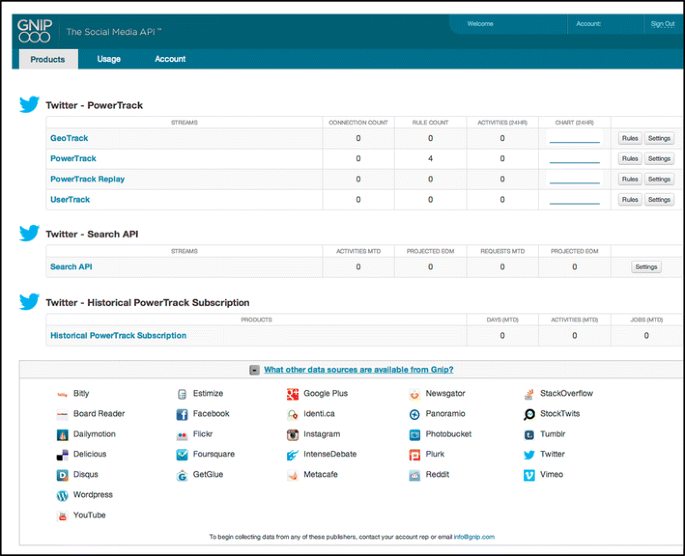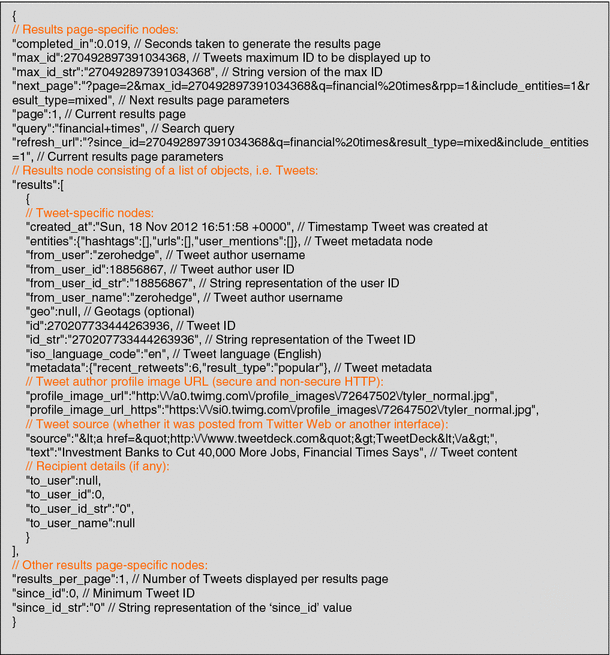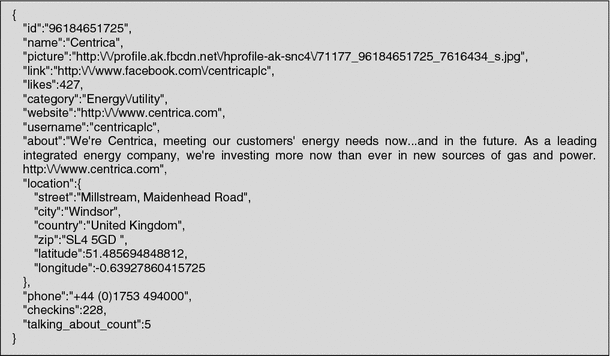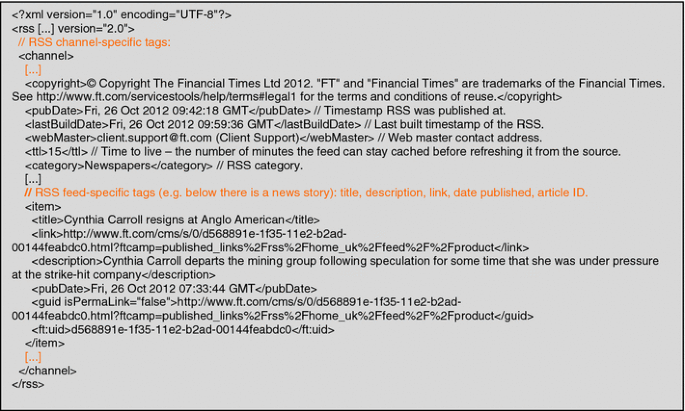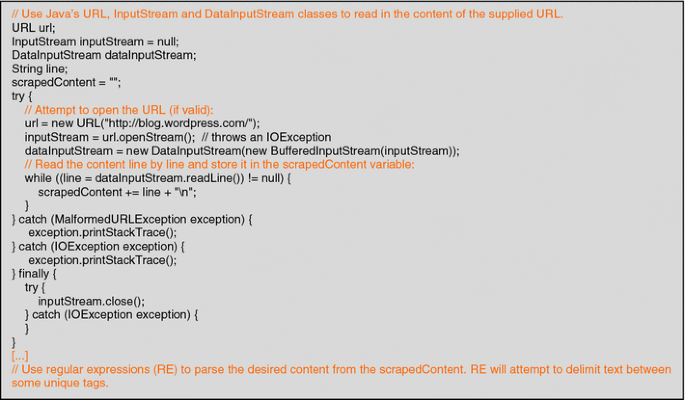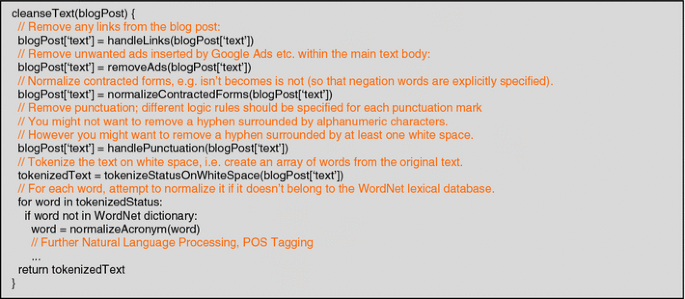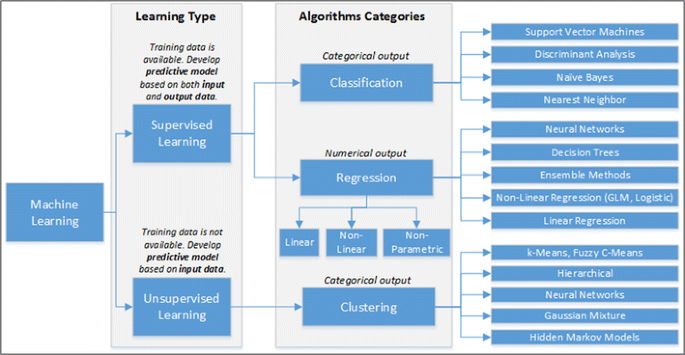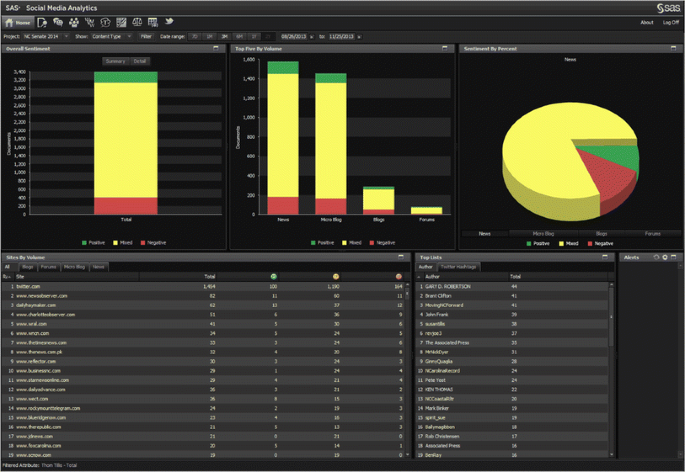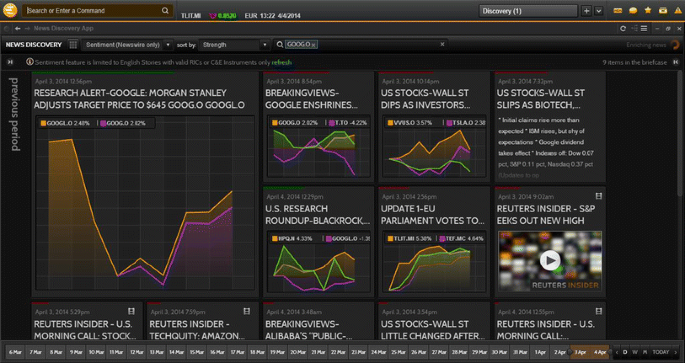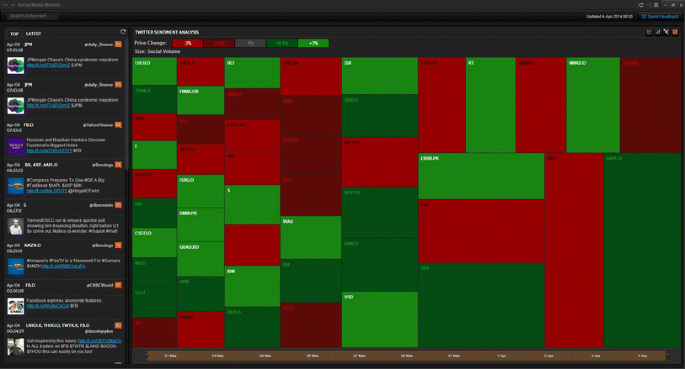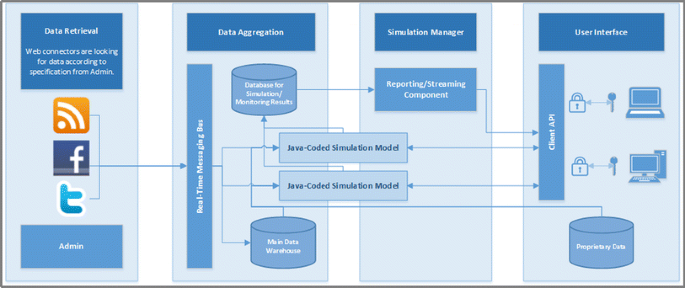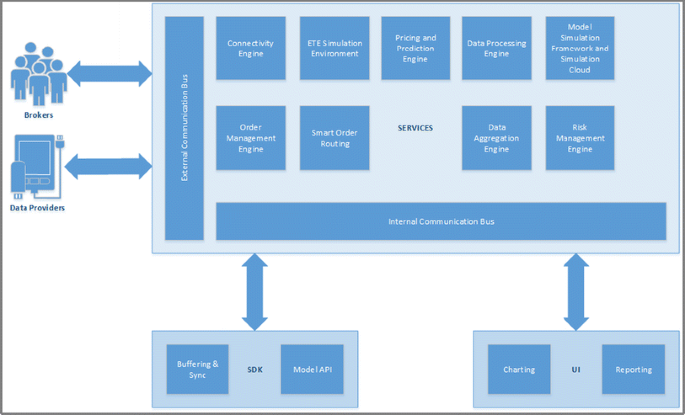Abstract
This paper is written for (social science) researchers seeking to analyze the wealth of social media now available. It presents a comprehensive review of software tools for social networking media, wikis, really simple syndication feeds, blogs, newsgroups, chat and news feeds. For completeness, it also includes introductions to social media scraping, storage, data cleaning and sentiment analysis. Although principally a review, the paper also provides a methodology and a critique of social media tools. Analyzing social media, in particular Twitter feeds for sentiment analysis, has become a major research and business activity due to the availability of web-based application programming interfaces (APIs) provided by Twitter, Facebook and News services. This has led to an ‘explosion’ of data services, software tools for scraping and analysis and social media analytics platforms. It is also a research area undergoing rapid change and evolution due to commercial pressures and the potential for using social media data for computational (social science) research. Using a simple taxonomy, this paper provides a review of leading software tools and how to use them to scrape, cleanse and analyze the spectrum of social media. In addition, it discussed the requirement of an experimental computational environment for social media research and presents as an illustration the system architecture of a social media (analytics) platform built by University College London. The principal contribution of this paper is to provide an overview (including code fragments) for scientists seeking to utilize social media scraping and analytics either in their research or business. The data retrieval techniques that are presented in this paper are valid at the time of writing this paper (June 2014), but they are subject to change since social media data scraping APIs are rapidly changing.
Similar content being viewed by others
1 Introduction
Social media is defined as web-based and mobile-based Internet applications that allow the creation, access and exchange of user-generated content that is ubiquitously accessible (Kaplan and Haenlein 2010). Besides social networking media (e.g., Twitter and Facebook), for convenience, we will also use the term ‘social media’ to encompass really simple syndication (RSS) feeds, blogs, wikis and news, all typically yielding unstructured text and accessible through the web. Social media is especially important for research into computational social science that investigates questions (Lazer et al. 2009) using quantitative techniques (e.g., computational statistics, machine learning and complexity) and so-called big data for data mining and simulation modeling (Cioffi-Revilla 2010).
This has led to numerous data services, tools and analytics platforms. However, this easy availability of social media data for academic research may change significantly due to commercial pressures. In addition, as discussed in Sect. 2, the tools available to researchers are far from ideal. They either give superficial access to the raw data or (for non-superficial access) require researchers to program analytics in a language such as Java.
1.1 Terminology
We start with definitions of some of the key techniques related to analyzing unstructured textual data:
-
Natural language processing—(NLP) is a field of computer science, artificial intelligence and linguistics concerned with the interactions between computers and human (natural) languages. Specifically, it is the process of a computer extracting meaningful information from natural language input and/or producing natural language output.
-
News analytics—the measurement of the various qualitative and quantitative attributes of textual (unstructured data) news stories. Some of these attributes are: sentiment, relevance and novelty.
-
Opinion mining—opinion mining (sentiment mining, opinion/sentiment extraction) is the area of research that attempts to make automatic systems to determine human opinion from text written in natural language.
-
Scraping—collecting online data from social media and other Web sites in the form of unstructured text and also known as site scraping, web harvesting and web data extraction.
-
Sentiment analysis—sentiment analysis refers to the application of natural language processing, computational linguistics and text analytics to identify and extract subjective information in source materials.
-
Text analytics—involves information retrieval (IR), lexical analysis to study word frequency distributions, pattern recognition, tagging/annotation, information extraction, data mining techniques including link and association analysis, visualization and predictive analytics.
1.2 Research challenges
Social media scraping and analytics provides a rich source of academic research challenges for social scientists, computer scientists and funding bodies. Challenges include:
-
Scraping—although social media data is accessible through APIs, due to the commercial value of the data, most of the major sources such as Facebook and Google are making it increasingly difficult for academics to obtain comprehensive access to their ‘raw’ data; very few social data sources provide affordable data offerings to academia and researchers. News services such as Thomson Reuters and Bloomberg typically charge a premium for access to their data. In contrast, Twitter has recently announced the Twitter Data Grants program, where researchers can apply to get access to Twitter’s public tweets and historical data in order to get insights from its massive set of data (Twitter has more than 500 million tweets a day).
-
Data cleansing—cleaning unstructured textual data (e.g., normalizing text), especially high-frequency streamed real-time data, still presents numerous problems and research challenges.
-
Holistic data sources—researchers are increasingly bringing together and combining novel data sources: social media data, real-time market & customer data and geospatial data for analysis.
-
Data protection—once you have created a ‘big data’ resource, the data needs to be secured, ownership and IP issues resolved (i.e., storing scraped data is against most of the publishers’ terms of service), and users provided with different levels of access; otherwise, users may attempt to ‘suck’ all the valuable data from the database.
-
Data analytics—sophisticated analysis of social media data for opinion mining (e.g., sentiment analysis) still raises a myriad of challenges due to foreign languages, foreign words, slang, spelling errors and the natural evolving of language.
-
Analytics dashboards—many social media platforms require users to write APIs to access feeds or program analytics models in a programming language, such as Java. While reasonable for computer scientists, these skills are typically beyond most (social science) researchers. Non-programming interfaces are required for giving what might be referred to as ‘deep’ access to ‘raw’ data, for example, configuring APIs, merging social media feeds, combining holistic sources and developing analytical models.
-
Data visualization—visual representation of data whereby information that has been abstracted in some schematic form with the goal of communicating information clearly and effectively through graphical means. Given the magnitude of the data involved, visualization is becoming increasingly important.
1.3 Social media research and applications
Social media data is clearly the largest, richest and most dynamic evidence base of human behavior, bringing new opportunities to understand individuals, groups and society. Innovative scientists and industry professionals are increasingly finding novel ways of automatically collecting, combining and analyzing this wealth of data. Naturally, doing justice to these pioneering social media applications in a few paragraphs is challenging. Three illustrative areas are: business, bioscience and social science.
The early business adopters of social media analysis were typically companies in retail and finance. Retail companies use social media to harness their brand awareness, product/customer service improvement, advertising/marketing strategies, network structure analysis, news propagation and even fraud detection. In finance, social media is used for measuring market sentiment and news data is used for trading. As an illustration, Bollen et al. (2011) measured sentiment of random sample of Twitter data, finding that Dow Jones Industrial Average (DJIA) prices are correlated with the Twitter sentiment 2–3 days earlier with 87.6 percent accuracy. Wolfram (2010) used Twitter data to train a Support Vector Regression (SVR) model to predict prices of individual NASDAQ stocks, finding ‘significant advantage’ for forecasting prices 15 min in the future.
In the biosciences, social media is being used to collect data on large cohorts for behavioral change initiatives and impact monitoring, such as tackling smoking and obesity or monitoring diseases. An example is Penn State University biologists (Salathé et al. 2012) who have developed innovative systems and techniques to track the spread of infectious diseases, with the help of news Web sites, blogs and social media.
Computational social science applications include: monitoring public responses to announcements, speeches and events especially political comments and initiatives; insights into community behavior; social media polling of (hard to contact) groups; early detection of emerging events, as with Twitter. For example, Lerman et al. (2008) use computational linguistics to automatically predict the impact of news on the public perception of political candidates. Yessenov and Misailovic (2009) use movie review comments to study the effect of various approaches in extracting text features on the accuracy of four machine learning methods—Naive Bayes, Decision Trees, Maximum Entropy and K-Means clustering. Lastly, Karabulut (2013) found that Facebook’s Gross National Happiness (GNH) exhibits peaks and troughs in-line with major public events in the USA.
1.4 Social media overview
For this paper, we group social media tools into:
-
Social media data—social media data types (e.g., social network media, wikis, blogs, RSS feeds and news, etc.) and formats (e.g., XML and JSON). This includes data sets and increasingly important real-time data feeds, such as financial data, customer transaction data, telecoms and spatial data.
-
Social media programmatic access—data services and tools for sourcing and scraping (textual) data from social networking media, wikis, RSS feeds, news, etc. These can be usefully subdivided into:
-
Data sources, services and tools—where data is accessed by tools which protect the raw data or provide simple analytics. Examples include: Google Trends, SocialMention, SocialPointer and SocialSeek, which provide a stream of information that aggregates various social media feeds.
-
Data feeds via APIs—where data sets and feeds are accessible via programmable HTTP-based APIs and return tagged data using XML or JSON, etc. Examples include Wikipedia, Twitter and Facebook.
-
-
Text cleaning and storage tools—tools for cleaning and storing textual data. Google Refine and DataWrangler are examples for data cleaning.
-
Text analysis tools—individual or libraries of tools for analyzing social media data once it has been scraped and cleaned. These are mainly natural language processing, analysis and classification tools, which are explained below.
-
Transformation tools—simple tools that can transform textual input data into tables, maps, charts (line, pie, scatter, bar, etc.), timeline or even motion (animation over timeline), such as Google Fusion Tables, Zoho Reports, Tableau Public or IBM’s Many Eyes.
-
Analysis tools—more advanced analytics tools for analyzing social data, identifying connections and building networks, such as Gephi (open source) or the Excel plug-in NodeXL.
-
-
Social media platforms—environments that provide comprehensive social media data and libraries of tools for analytics. Examples include: Thomson Reuters Machine Readable News, Radian 6 and Lexalytics.
-
Social network media platforms—platforms that provide data mining and analytics on Twitter, Facebook and a wide range of other social network media sources.
-
News platforms—platforms such as Thomson Reuters providing commercial news archives/feeds and associated analytics.
-
2 Social media methodology and critique
The two major impediments to using social media for academic research are firstly access to comprehensive data sets and secondly tools that allow ‘deep’ data analysis without the need to be able to program in a language such as Java. The majority of social media resources are commercial and companies are naturally trying to monetize their data. As discussed, it is important that researchers have access to open-source ‘big’ (social media) data sets and facilities for experimentation. Otherwise, social media research could become the exclusive domain of major companies, government agencies and a privileged set of academic researchers presiding over private data from which they produce papers that cannot be critiqued or replicated. Recently, there has been a modest response, as Twitter and Gnip are piloting a new program for data access, starting with 5 all-access data grants to select applicants.
2.1 Methodology
Research requirements can be grouped into: data, analytics and facilities.
2.1.1 Data
Researchers need online access to historic and real-time social media data, especially the principal sources, to conduct world-leading research:
-
Social network media—access to comprehensive historic data sets and also real-time access to sources, possibly with a (15 min) time delay, as with Thomson Reuters and Bloomberg financial data.
-
News data—access to historic data and real-time news data sets, possibly through the concept of ‘educational data licenses’ (cf. software license).
-
Public data—access to scraped and archived important public data; available through RSS feeds, blogs or open government databases.
-
Programmable interfaces—researchers also need access to simple application programming interfaces (APIs) to scrape and store other available data sources that may not be automatically collected.
2.1.2 Analytics
Currently, social media data is typically either available via simple general routines or require the researcher to program their analytics in a language such as MATLAB, Java or Python. As discussed above, researchers require:
-
Analytics dashboards—non-programming interfaces are required for giving what might be termed as ‘deep’ access to ‘raw’ data.
-
Holistic data analysis—tools are required for combining (and conducting analytics across) multiple social media and other data sets.
-
Data visualization—researchers also require visualization tools whereby information that has been abstracted can be visualized in some schematic form with the goal of communicating information clearly and effectively through graphical means.
2.1.3 Facilities
Lastly, the sheer volume of social media data being generated argues for national and international facilities to be established to support social media research (cf. Wharton Research Data Services https://wrds-web.wharton.upenn.edu):
-
Data storage—the volume of social media data, current and projected, is beyond most individual universities and hence needs to be addressed at a national science foundation level. Storage is required both for principal data sources (e.g., Twitter), but also for sources collected by individual projects and archived for future use by other researchers.
-
Computational facility—remotely accessible computational facilities are also required for: a) protecting access to the stored data; b) hosting the analytics and visualization tools; and c) providing computational resources such as grids and GPUs required for processing the data at the facility rather than transmitting it across a network.
2.2 Critique
Much needs to be done to support social media research. As discussed, the majority of current social media resources are commercial, expensive and difficult for academics to obtain full access.
2.2.1 Data
In general, access to important sources of social media data is frequently restricted and full commercial access is expensive.
-
Siloed data—most data sources (e.g., Twitter) have inherently isolated information making it difficult to combine with other data sources.
-
Holistic data—in contrast, researchers are increasingly interested in accessing, storing and combining novel data sources: social media data, real-time financial market & customer data and geospatial data for analysis. This is currently extremely difficult to do even for Computer Science departments.
2.2.2 Analytics
Analytical tools provided by vendors are often tied to a single data set, maybe limited in analytical capability, and data charges make them expensive to use.
2.2.3 Facilities
There are an increasing number of powerful commercial platforms, such as the ones supplied by SAS and Thomson Reuters, but the charges are largely prohibitive for academic research. Either comparable facilities need to be provided by national science foundations or vendors need to be persuaded to introduce the concept of an ‘educational license.’
3 Social media data
Clearly, there is a large and increasing number of (commercial) services providing access to social networking media (e.g., Twitter, Facebook and Wikipedia) and news services (e.g., Thomson Reuters Machine Readable News). Equivalent major academic services are scarce.We start by discussing types of data and formats produced by these services.
3.1 Types of data
Although we focus on social media, as discussed, researchers are continually finding new and innovative sources of data to bring together and analyze. So when considering textual data analysis, we should consider multiple sources (e.g., social networking media, RSS feeds, blogs and news) supplemented by numeric (financial) data, telecoms data, geospatial data and potentially speech and video data. Using multiple data sources is certainly the future of analytics.
Broadly, data subdivides into:
-
Historic data sets—previously accumulated and stored social/news, financial and economic data.
-
Real-time feeds—live data feeds from streamed social media, news services, financial exchanges, telecoms services, GPS devices and speech.
And into:
-
Raw data—unprocessed computer data straight from source that may contain errors or may be unanalyzed.
-
Cleaned data—correction or removal of erroneous (dirty) data caused by disparities, keying mistakes, missing bits, outliers, etc.
-
Value-added data—data that has been cleaned, analyzed, tagged and augmented with knowledge.
3.2 Text data formats
The four most common formats used to markup text are: HTML, XML, JSON and CSV.
-
HTML—HyperText Markup Language (HTML) as well-known is the markup language for web pages and other information that can be viewed in a web browser. HTML consists of HTML elements, which include tags enclosed in angle brackets (e.g., <div>), within the content of the web page.
-
XML—Extensible Markup Language (XML)—the markup language for structuring textual data using <tag>…<\tag> to define elements.
-
JSON—JavaScript Object Notation (JSON) is a text-based open standard designed for human-readable data interchange and is derived from JavaScript.
-
CSV—a comma-separated values (CSV) file contains the values in a table as a series of ASCII text lines organized such that each column value is separated by a comma from the next column’s value and each row starts a new line.
For completeness, HTML and XML are so-called markup languages (markup and content) that define a set of simple syntactic rules for encoding documents in a format both human readable and machine readable. A markup comprises start-tags (e.g., <tag>), content text and end-tags (e.g., </tag>).
Many feeds use JavaScript Object Notation (JSON), the lightweight data-interchange format, based on a subset of the JavaScript Programming Language. JSON is a language-independent text format that uses conventions that are familiar to programmers of the C-family of languages, including C, C++, C#, Java, JavaScript, Perl, Python, and many others. JSON’s basic types are: Number, String, Boolean, Array (an ordered sequence of values, comma-separated and enclosed in square brackets) and Object (an unordered collection of key:value pairs). The JSON format is illustrated in Fig. 1 for a query on the Twitter API on the string ‘UCL,’ which returns two ‘text’ results from the Twitter user ‘uclnews.’
Comma-separated values are not a single, well-defined format but rather refer to any text file that: (a) is plain text using a character set such as ASCII, Unicode or EBCDIC; (b) consists of text records (e.g., one record per line); (c) with records divided into fields separated by delimiters (e.g., comma, semicolon and tab); and (d) where every record has the same sequence of fields.
4 Social media providers
Social media data resources broadly subdivide into those providing:
-
Freely available databases—repositories that can be freely downloaded, e.g., Wikipedia (http://dumps.wikimedia.org) and the Enron e-mail data set available via http://www.cs.cmu.edu/~enron/.
-
Data access via tools—sources that provide controlled access to their social media data via dedicated tools, both to facilitate easy interrogation and also to stop users ‘sucking’ all the data from the repository. An example is Google’s Trends. These further subdivided into:
-
Free sources—repositories that are freely accessible, but the tools protect or may limit access to the ‘raw’ data in the repository, such as the range of tools provided by Google.
-
Commercial sources—data resellers that charge for access to their social media data. Gnip and DataSift provide commercial access to Twitter data through a partnership, and Thomson Reuters to news data.
-
-
Data access via APIs—social media data repositories providing programmable HTTP-based access to the data via APIs (e.g., Twitter, Facebook and Wikipedia).
4.1 Open-source databases
A major open source of social media is Wikipedia, which offers free copies of all available content to interested users (Wikimedia Foundation 2014). These databases can be used for mirroring, database queries and social media analytics. They include dumps from any Wikimedia Foundation project: http://dumps.wikimedia.org/, English Wikipedia dumps in SQL and XML: http://dumps.wikimedia.org/enwiki/, etc.
Another example of freely available data for research is the World Bank data, i.e., the World Bank Databank (http://databank.worldbank.org/data/databases.aspx ), which provides over 40 databases, such as Gender Statistics, Health Nutrition and Population Statistics, Global Economic Prospects, World Development Indicators and Global Development Finance, and many others. Most of the databases can be filtered by country/region, series/topics or time (years and quarters). In addition, tools are provided to allow reports to be customized and displayed in table, chart or map formats.
4.2 Data access via tools
As discussed, most commercial services provide access to social media data via online tools, both to control access to the raw data and increasingly to monetize the data.
4.2.1 Freely accessible sources
Google with tools such as Trends and InSights is a good example of this category. Google is the largest ‘scraper’ in the world, but they do their best to ‘discourage’ scraping of their own pages. (For an introduction of how to surreptitious scrape Google—and avoid being ‘banned’—see http://google-scraper.squabbel.com.) Google’s strategy is to provide a wide range of packages, such as Google Analytics, rather than from a researchers’ viewpoint the more useful programmable HTTP-based APIs.
Figure 2 illustrates how Google Trends displays a particular search term, in this case ‘libor.’ Using Google Trends you can compare up to five topics at a time and also see how often those topics have been mentioned and in which geographic regions the topics have been searched for the most.
4.2.2 Commercial sources
There is an increasing number of commercial services that scrape social networking media and then provide paid-for access via simple analytics tools. (The more comprehensive platforms with extensive analytics are reviewed in Sect. 8.) In addition, companies such as Twitter are both restricting free access to their data and licensing their data to commercial data resellers, such as Gnip and DataSift.
Gnip is the world’s largest provider of social data. Gnip was the first to partner with Twitter to make their social data available, and since then, it was the first to work with Tumblr, Foursquare, WordPress, Disqus, StockTwits and other leading social platforms. Gnip delivers social data to customers in more than 40 countries, and Gnip’s customers deliver social media analytics to more than 95 % of the Fortune 500. Real-time data from Gnip can be delivered as a ‘Firehose’ of every single activity or via PowerTrack, a proprietary filtering tool that allows users to build queries around only the data they need. PowerTrack rules can filter data streams based on keywords, geo boundaries, phrase matches and even the type of content or media in the activity. The company then offers enrichments to these data streams such as Profile Geo (to add significantly more usable geo data for Twitter), URL expansion and language detection to further enhance the value of the data delivered. In addition to real-time data access, the company also offers Historical PowerTrack and Search API access for Twitter which give customers the ability to pull any Tweet since the first message on March 21, 2006.
Gnip provides access to premium (Gnip’s ‘Complete Access’ sources are publishers that have an agreement with Gnip to resell their data) and free data feeds (Gnip’s ‘Managed Public API Access’ sources provide access to normalized and consolidated free data from their APIs, although it requires Gnip’s paid services for the Data Collectors) via its dashboard (see Fig. 3). Firstly, the user only sees the feeds in the dashboard that were paid for under a sales agreement. To select a feed, the user clicks on a publisher and then chooses a specific feed from that publisher as shown in Fig. 3. Different types of feeds serve different types of use cases and correspond to different types of queries and API endpoints on the publisher’s source API. After selecting the feed, the user is assisted by Gnip to configure it with any required parameters before it begins collecting data. This includes adding at least one rule. Under ‘Get Data’ – > ‘Advanced Settings’ you can also configure how often your feed queries the source API for data (the ‘query rate’). Choose between the publisher’s native data format and Gnip’s Activity Streams format (XML for Enterprise Data Collector feeds).
4.3 Data feed access via APIs
For researchers, arguably the most useful sources of social media data are those that provide programmable access via APIs, typically using HTTP-based protocols. Given their importance to academics, here, we review individually wikis, social networking media, RSS feeds, news, etc.
4.3.1 Wiki media
Wikipedia (and wikis in general) provides academics with large open-source repositories of user-generated (crowd-sourced) content. What is not widely known is that Wikipedia provides HTTP-based APIs that allows programmable access and searching (i.e., scraping) that returns data in a variety of formats including XML. In fact, the API is not unique to Wikipedia but part of MediaWiki’s (http://www.mediawiki.org/) open-source toolkit and hence can be used with any MediaWiki-based wikis.
The wiki HTTP-based API works by accepting requests containing one or more input arguments and returning strings, often in XML format, that can be parsed and used by the requesting client. Other formats supported include JSON, WDDX, YAML, or PHP serialized. Details can be found at: http://en.wikipedia.org/w/api.php?action=query&list=allcategories&acprop=size&acprefix=hollywood&format=xml.
The HTTP request must contain: a) the requested ‘action,’ such as query, edit or delete operation; b) an authentication request; and c) any other supported actions. For example, the above request returns an XML string listing the first 10 Wikipedia categories with the prefix ‘hollywood.’ Vaswani (2011) provides a detailed description of how to scrape Wikipedia using an Apache/PHP development environment and an HTTP client capable of transmitting GET and PUT requests and handling responses.
4.3.2 Social networking media
As with Wikipedia, popular social networks, such as Facebook, Twitter and Foursquare, make a proportion of their data accessible via APIs.
Although many social networking media sites provide APIs, not all sites (e.g., Bing, LinkedIn and Skype) provide API access for scraping data. While more and more social networks are shifting to publicly available content, many leading networks are restricting free access, even to academics. For example, Foursquare announced in December 2013 that it will no longer allow private check-ins on iOS 7, and has now partnered with Gnip to provide a continuous stream of anonymized check-in data. The data is available in two packages: the full Firehose access level and a filtered version via Gnip’s PowerTrack service. Here, we briefly discuss the APIs provided by Twitter and Facebook.
4.3.2.1 Twitter
The default account setting keeps users’ Tweets public, although users can protect their Tweets and make them visible only to their approved Twitter followers. However, less than 10 % of all the Twitter accounts are private. Tweets from public accounts (including replies and mentions) are available in JSON format through Twitter’s Search API for batch requests of past data and Streaming API for near real-time data.
-
Search API—Query Twitter for recent Tweets containing specific keywords. It is part of the Twitter REST API v1.1 (it attempts to comply with the design principles of the REST architectural style, which stands for Representational State Transfer) and requires an authorized application (using oAuth, the open standard for authorization) before retrieving any results from the API.
-
Streaming API—A real-time stream of Tweets, filtered by user ID, keyword, geographic location or random sampling.
One may retrieve recent Tweets containing particular keywords through Twitter’s Search API (part of REST API v1.1) with the following API call: https://api.twitter.com/1.1/search/tweets.json?q=APPLE and real-time data using the streaming API call: https://stream.twitter.com/1/statuses/sample.json.
Twitter’s Streaming API allows data to be accessed via filtering (by keywords, user IDs or location) or by sampling of all updates from a select amount of users. Default access level ‘Spritzer’ allows sampling of roughly 1 % of all public statuses, with the option to retrieve 10 % of all statuses via the ‘Gardenhose’ access level (more suitable for data mining and research applications). In social media, streaming APIs are often called Firehose—a syndication feed that publishes all public activities as they happen in one big stream. Twitter has recently announced the Twitter Data Grants program, where researchers can apply to get access to Twitter’s public tweets and historical data in order to get insights from its massive set of data (Twitter has more than 500 million tweets a day); research institutions and academics will not get the Firehose access level; instead, they will only get the data set needed for their research project. Researchers can apply for it at the following address: https://engineering.twitter.com/research/data-grants.
Twitter results are stored in a JSON array of objects containing the fields shown in Fig. 4. The JSON array consists of a list of objects matching the supplied filters and the search string, where each object is a Tweet and its structure is clearly specified by the object’s fields, e.g., ‘created_at’ and ‘from_user’. The example in Fig. 4 consists of the output of calling Twitter’s GET search API via http://search.twitter.com/search.json?q=financial%20times&rpp=1&include_entities=true&result_type=mixed where the parameters specify that the search query is ‘financial times,’ one result per page, each Tweet should have a node called ‘entities’ (i.e., metadata about the Tweet) and list ‘mixed’ results types, i.e., include both popular and real-time results in the response.
4.3.2.2 Facebook
Facebook’s privacy issues are more complex than Twitter’s, meaning that a lot of status messages are harder to obtain than Tweets, requiring ‘open authorization’ status from users. Facebook currently stores all data as objectsFootnote 1 and has a series of APIs, ranging from the Graph and Public Feed APIs to Keyword Insight API. In order to access the properties of an object, its unique ID must be known to make the API call. Facebook’s Search API (part of Facebook’s Graph API) can be accessed by calling https://graph.facebook.com/search?q=QUERY&type=page. The detailed API query format is shown in Fig. 5. Here, ‘QUERY’ can be replaced by any search term, and ‘page’ can be replaced with ‘post,’ ‘user,’ ‘page,’ ‘event,’ ‘group,’ ‘place,’ ‘checkin,’ ‘location’ or ‘placetopic.’ The results of this search will contain the unique ID for each object. When returning the individual ID for a particular search result, one can use https://graph.facebook.com/ID to obtain further page details such as number of ‘likes.’ This kind of information is of interest to companies when it comes to brand awareness and competition monitoring.
The Facebook Graph API search queries require an access token included in the request. Searching for pages and places requires an ‘app access token’, whereas searching for other types requires a user access token.
Replacing ‘page’ with ‘post’ in the aforementioned search URL will return all public statuses containing this search term.Footnote 2 Batch requests can be sent by following the procedure outlined here: https://developers.facebook.com/docs/reference/api/batch/. Information on retrieving real-time updates can be found here: https://developers.facebook.com/docs/reference/api/realtime/. Facebook also returns data in JSON format and so can be retrieved and stored using the same methods as used with data from Twitter, although the fields are different depending on the search type, as illustrated in Fig. 6.
4.3.3 RSS feeds
A large number of Web sites already provide access to content via RSS feeds. This is the syndication standard for publishing regular updates to web-based content based on a type of XML file that resides on an Internet server. For Web sites, RSS feeds can be created manually or automatically (with software).
An RSS Feed Reader reads the RSS feed file, finds what is new converts it to HTML and displays it. The program fragment in Fig. 7 shows the code for the control and channel statements for the RSS feed. The channel statements define the overall feed or channel, one set of channel statements in the RSS file.
4.3.4 Blogs, news groups and chat services
Blog scraping is the process of scanning through a large number of blogs, usually daily, searching for and copying content. This process is conducted through automated software. Figure 8 illustrates example code for Blog Scraping. This involves getting a Web site’s source code via Java’s URL Class, which can eventually be parsed via Regular Expressions to capture the target content.
4.3.5 News feeds
News feeds are delivered in a variety of textual formats, often as machine-readable XML documents, JSON or CSV files. They include numerical values, tags and other properties that tend to represent underlying news stories. For testing purposes, historical information is often delivered via flat files, while live data for production is processed and delivered through direct data feeds or APIs. Figure 9 shows a snippet of the software calls to retrieve filtered NY Times articles.
Having examined the ‘classic’ social media data feeds, as an illustration of scraping innovative data sources, we will briefly look at geospatial feeds.
4.3.6 Geospatial feeds
Much of the ‘geospatial’ social media data come from mobile devices that generate location- and time-sensitive data. One can differentiate between four types of mobile social media feeds (Kaplan 2012):
-
Location and time sensitive—exchange of messages with relevance for one specific location at one specific point-in time (e.g., Foursquare).
-
Location sensitive only—exchange of messages with relevance for one specific location, which are tagged to a certain place and read later by others (e.g., Yelp and Qype)
-
Time sensitive only—transfer of traditional social media applications to mobile devices to increase immediacy (e.g., posting Twitter messages or Facebook status updates)
-
Neither location or time sensitive—transfer of traditional social media applications to mobile devices (e.g., watching a YouTube video or reading a Wikipedia entry)
With increasingly advanced mobile devices, notably smartphones, the content (photos, SMS messages, etc.) has geographical identification added, called ‘geotagged.’ These geospatial metadata are usually latitude and longitude coordinates, though they can also include altitude, bearing, distance, accuracy data or place names. GeoRSS is an emerging standard to encode the geographic location into a web feed, with two primary encodings: GeoRSS Geography Markup Language (GML) and GeoRSS Simple.
Example tools are GeoNetwork Opensource—a free comprehensive cataloging application for geographically referenced information, and FeedBurner—a web feed provider that can also provide geotagged feeds, if the specified feeds settings allow it.
As an illustration Fig. 10 shows the pseudo-code for analyzing a geospatial feed.
5 Text cleaning, tagging and storing
The importance of ‘quality versus quantity’ of data in social media scraping and analytics cannot be overstated (i.e., garbage in and garbage out). In fact, many details of analytics models are defined by the types and quality of the data. The nature of the data will also influence the database and hardware used.
Naturally, unstructured textual data can be very noisy (i.e., dirty). Hence, data cleaning (or cleansing, scrubbing) is an important area in social media analytics. The process of data cleaning may involve removing typographical errors or validating and correcting values against a known list of entities. Specifically, text may contain misspelled words, quotations, program codes, extra spaces, extra line breaks, special characters, foreign words, etc. So in order to achieve high-quality text mining, it is necessary to conduct data cleaning at the first step: spell checking, removing duplicates, finding and replacing text, changing the case of text, removing spaces and non-printing characters from text, fixing numbers, number signs and outliers, fixing dates and times, transforming and rearranging columns, rows and table data, etc.
Having reviewed the types and sources of raw data, we now turn to ‘cleaning’ or ‘cleansing’ the data to remove incorrect, inconsistent or missing information. Before discussing strategies for data cleaning, it is essential to identify possible data problems (Narang 2009):
-
Missing data—when a piece of information existed but was not included for whatever reason in the raw data supplied. Problems occur with: a) numeric data when ‘blank’ or a missing value is erroneously substituted by ‘zero’ which is then taken (for example) as the current price; and b) textual data when a missing word (like ‘not’) may change the whole meaning of a sentence.
-
Incorrect data—when a piece of information is incorrectly specified (such as decimal errors in numeric data or wrong word in textual data) or is incorrectly interpreted (such as a system assuming a currency value is in $ when in fact it is in £ or assuming text is in US English rather than UK English).
-
Inconsistent data—when a piece of information is inconsistently specified. For example, with numeric data, this might be using a mixture of formats for dates: 2012/10/14, 14/10/2012 or 10/14/2012. For textual data, it might be as simple as: using the same word in a mixture of cases, mixing English and French in a text message, or placing Latin quotes in an otherwise English text.
5.1 Cleansing data
A traditional approach to text data cleaning is to ‘pull’ data into a spreadsheet or spreadsheet-like table and then reformat the text. For example, Google Refine Footnote 3 is a standalone desktop application for data cleaning and transformation to various formats. Transformation expressions are written in proprietary Google Refine Expression Language (GREL) or JYTHON (an implementation of the Python programming language written in Java). Figure 11 illustrates text cleansing.
5.2 Tagging unstructured data
Since most of the social media data is generated by humans and therefore is unstructured (i.e., it lacks a pre-defined structure or data model), an algorithm is required to transform it into structured data to gain any insight. Therefore, unstructured data need to be preprocessed, tagged and then parsed in order to quantify/analyze the social media data.
Adding extra information to the data (i.e., tagging the data) can be performed manually or via rules engines, which seek patterns or interpret the data using techniques such as data mining and text analytics. Algorithms exploit the linguistic, auditory and visual structure inherent in all of the forms of human communication. Tagging the unstructured data usually involve tagging the data with metadata or part-of-speech (POS) tagging. Clearly, the unstructured nature of social media data leads to ambiguity and irregularity when it is being processed by a machine in an automatic fashion.
Using a single data set can provide some interesting insights. However, combining more data sets and processing the unstructured data can result in more valuable insights, allowing us to answer questions that were impossible beforehand.
5.3 Storing data
As discussed, the nature of the social media data is highly influential on the design of the database and possibly the supporting hardware. It would also be very important to note that each social platform has very specific (and narrow) rules around how their respective data can be stored and used. These can be found in the Terms of Service for each platform.
For completeness, databases comprise:
-
Flat file—a flat file is a two-dimensional database (somewhat like a spreadsheet) containing records that have no structured interrelationship, that can be searched sequentially.
-
Relational database—a database organized as a set of formally described tables to recognize relations between stored items of information, allowing more complex relationships among the data items. Examples are row-based SQL databases and column-based kdb + used in finance.
-
noSQL databases—a class of database management system (DBMS) identified by its non-adherence to the widely used relational database management system (RDBMS) model. noSQL/newSQL databases are characterized as: being non-relational, distributed, open-source and horizontally scalable.
5.3.1 Apache (noSQL) databases and tools
The growth of ultra-large Web sites such as Facebook and Google has led to the development of noSQL databases as a way of breaking through the speed constraints that relational databases incur. A key driver has been Google’s MapReduce, i.e., the software framework that allows developers to write programs that process massive amounts of unstructured data in parallel across a distributed cluster of processors or stand-alone computers (Chandrasekar and Kowsalya 2011). It was developed at Google for indexing Web pages and replaced their original indexing algorithms and heuristics in 2004. The model is inspired by the ‘Map’ and ‘Reduce’ functions commonly used in functional programming. MapReduce (conceptually) takes as input a list of records, and the ‘Map’ computation splits them among the different computers in a cluster. The result of the Map computation is a list of key/value pairs. The corresponding ‘Reduce’ computation takes each set of values that has the same key and combines them into a single value. A MapReduce program is composed of a ‘Map()’ procedure for filtering and sorting and a ‘Reduce()’ procedure for a summary operation (e.g., counting and grouping).
Figure 12 provides a canonical example application of MapReduce. This example is a process to count the appearances of each different word in a set of documents (MapReduce 2011).
5.3.1.1 Apache open-source software
The research community is increasingly using Apache software for social media analytics. Within the Apache Software Foundation, three levels of software are relevant:
-
Cassandra/hive databases—Apache Cassandra is an open source (noSQL) distributed DBMS providing a structured ‘key-value’ store. Key-value stores allow an application to store its data in a schema-less way. Related noSQL database products include: Apache Hive, Apache Pig and MongoDB, a scalable and high-performance open-source database designed to handle document-oriented storage. Since noSQL databases are ‘structure-less,’ it is necessary to have a companion SQL database to retain and map the structure of the corresponding data.
-
Hadoop platform—is a Java-based programming framework that supports the processing of large data sets in a distributed computing environment. An application is broken down into numerous small parts (also called fragments or blocks) that can be run on systems with thousands of nodes involving thousands of terabytes of storage.
-
Mahout—provides implementations of distributed or otherwise scalable analytics (machine learning) algorithms running on the Hadoop platform. MahoutFootnote 4 supports four classes of algorithms: a) clustering (e.g., K-Means, Fuzzy C-Means) that groups text into related groups; b) classification (e.g., Complementary Naive Bayes classifier) that uses supervised learning to classify text; c) frequent itemset mining takes a set of item groups and identifies which individual items usually appear together; and d) recommendation mining (e.g., user- and item-based recommenders) that takes users’ behavior and from that tries to find items users might like.
6 Social media analytics techniques
As discussed, opinion mining (or sentiment analysis) is an attempt to take advantage of the vast amounts of user-generated text and news content online. One of the primary characteristics of such content is its textual disorder and high diversity. Here, natural language processing, computational linguistics and text analytics are deployed to identify and extract subjective information from source text. The general aim is to determine the attitude of a writer (or speaker) with respect to some topic or the overall contextual polarity of a document.
6.1 Computational science techniques
Automated sentiment analysis of digital texts uses elements from machine learning such as latent semantic analysis, support vector machines, bag-of-words model and semantic orientation (Turney 2002). In simple terms, the techniques employ three broad areas:
-
Computational statistics—refers to computationally intensive statistical methods including resampling methods, Markov chain Monte Carlo methods, local regression, kernel density estimation and principal components analysis.
-
Machine learning—a system capable of the autonomous acquisition and integration of knowledge learnt from experience, analytical observation, etc. (Murphy 2012). These sub-symbolic systems further subdivide into:
-
Supervised learning such as Regression Trees, Discriminant Function Analysis, Support Vector Machines.
-
Unsupervised learning such as Self-Organizing Maps (SOM), K-Means.
-
Machine Learning aims to solve the problem of having huge amounts of data with many variables and is commonly used in areas such as pattern recognition (speech, images), financial algorithms (credit scoring, algorithmic trading) (Nuti et al. 2011), energy forecasting (load, price) and biology (tumor detection, drug discovery). Figure 13 illustrates the two learning types of machine learning and their algorithm categories.
-
Complexity science—complex simulation models of difficult-to-predict systems derived from statistical physics, information theory and nonlinear dynamics. The realm of physicists and mathematicians.
These techniques are deployed in two ways:
-
Data mining—knowledge discovery that extracts hidden patterns from huge quantities of data, using sophisticated differential equations, heuristics, statistical discriminators (e.g., hidden Markov models), and artificial intelligence machine learning techniques (e.g., neural networks, genetic algorithms and support vector machines).
-
Simulation modeling—simulation-based analysis that tests hypotheses. Simulation is used to attempt to predict the dynamics of systems so that the validity of the underlying assumption can be tested.
6.1.1 Stream processing
Lastly, we should mention stream processing (Botan et al 2010). Increasingly, analytics applications that consume real-time social media, financial ‘ticker’ and sensor networks data need to process high-volume temporal data with low latency. These applications require support for online analysis of rapidly changing data streams. However, traditional database management systems (DBMSs) have no pre-defined notion of time and cannot handle data online in near real time. This has led to the development of Data Stream Management Systems (DSMSs) (Hebrail 2008)—processing in main memory without storing the data on disk—that handle transient data streams on-line and process continuous queries on these data streams. Example commercial systems include: Oracle CEP engine, StreamBase and Microsoft’s StreamInsight (Chandramouli et al. 2010).
6.2 Sentiment analysis
Sentiment is about mining attitudes, emotions, feelings—it is subjective impressions rather than facts. Generally speaking, sentiment analysis aims to determine the attitude expressed by the text writer or speaker with respect to the topic or the overall contextual polarity of a document (Mejova 2009). Pang and Lee (2008) provide a thorough documentation on the fundamentals and approaches of sentiment classification and extraction, including sentiment polarity, degrees of positivity, subjectivity detection, opinion identification, non-factual information, term presence versus frequency, POS (parts of speech), syntax, negation, topic-oriented features and term-based features beyond term unigrams.
6.2.1 Sentiment classification
Sentiment analysis divides into specific subtasks:
-
Sentiment context—to extract opinion, one needs to know the ‘context’ of the text, which can vary significantly from specialist review portals/feeds to general forums where opinions can cover a spectrum of topics (Westerski 2008).
-
Sentiment level—text analytics can be conducted at the document, sentence or attribute level.
-
Sentiment subjectivity—deciding whether a given text expresses an opinion or is factual (i.e., without expressing a positive/negative opinion).
-
Sentiment orientation/polarity—deciding whether an opinion in a text is positive, neutral or negative.
-
Sentiment strength—deciding the ‘strength’ of an opinion in a text: weak, mild or strong.
Perhaps, the most difficult analysis is identifying sentiment orientation/polarity and strength—positive (wonderful, elegant, amazing, cool), neutral (fine, ok) and negative (horrible, disgusting, poor, flakey, sucks) due to slang.
A popular approach is to assign orientation/polarity scores (+1, 0, −1) to all words: positive opinion (+1), neutral opinion (0) and negative opinion (−1). The overall orientation/polarity score of the text is the sum of orientation scores of all ‘opinion’ words found. However, there are various potential problems in this simplistic approach, such as negation (e.g., there is nothing I hate about this product). One method of estimating sentiment orientation/polarity of the text is pointwise mutual information (PMI) a measure of association used in information theory and statistics.
6.2.2 Supervised learning methods
There are a number of popular computational statistics and machine learning techniques used for sentiment analysis. For a good introduction, see (Khan et al 2010). Techniques include:
-
Naïve Bayes (NB)—a simple probabilistic classifier based on applying Bayes’ theorem with strong (naive) independence assumptions (when features are independent of one another within each class).
-
Maximum entropy (ME)—the probability distribution that best represents the current state of knowledge is the one with largest information-theoretical entropy.
-
Support vector machines (SVM)—are supervised learning models with associated learning algorithms that analyze data and recognize patterns, used for classification and regression analysis.
-
Logistic regression (LR) model—is a type of regression analysis used for predicting the outcome of a categorical (a variable that can take on a limited number of categories) criterion variable based on one or more predictor variables.
-
Latent semantic analysis—an indexing and retrieval method that uses a mathematical technique called singular value decomposition (SVD) to identify patterns in the relationships between the terms and concepts contained in an unstructured collection of text (Kobayashi and Takeda 2000).
The bag-of-words model is a simplifying representation commonly used in natural language processing and IR, where a sentence or a document is represented as an unordered collection of words, disregarding grammar and even word order. This is a model traditionally applied to sentiment analysis thanks to its simplicity.
6.2.2.1 Naïve Bayes classifier (NBC)
As an example of sentiment analysis, we will describe briefly a Naive Bayes classifier (Murphy 2006). The Naive Bayes classifier is general purpose, simple to implement and works well for a range of applications. It classifies data in two steps:
-
Training step—using the training samples, the method estimates the parameters of a probability distribution, assuming features are conditionally independent given the class.
-
Analysis/testing step—For any unseen test sample, the method computes the posterior probability of that sample belonging to each class. The method then classifies the test sample according to the largest posterior probability.
Using the Naïve Bayes classifier, the classifier calculates the probability for a text to belong to each of the categories you test against. The category with the highest probability for the given text wins:
Figure 14 provides an example of sentiment classification using a Naïve Bayes classifier in Python. There are a number of Naïve Bayes classifier programs available in Java, including the jBNC toolkit (http://jbnc.sourceforge.net), WEKA (www.cs.waikato.ac.nz/ml/weka) and Alchemy API (www.alchemyapi.com/api/demo.html).
We next look at the range of Social Media tools available, starting with ‘tools’ and ‘toolkits,’ and in the subsequent chapter at ‘comprehensive’ social media platforms. Since there are a large number of social media textual data services, tools and platforms, we will restrict ourselves examining a few leading examples.
7 Social media analytics tools
Opinion mining tools are crowded with (commercial) providers, most of which are skewed toward sentiment analysis of customer feedback about products and services. Fortunately, there is a vast spectrum of tools for textual analysis ranging from simple open-source tools to libraries, multi-function commercial toolkits and platforms. This section focuses on individual tools and toolkits for scraping, cleaning and analytics, and the next chapter looks at what we call social media platforms that provide both archive data and real-time feeds, and as well as sophisticated analytics tools.
7.1 Scientific programming tools
Popular scientific analytics libraries and tools have been enhanced to provide support for sourcing, searching and analyzing text. Examples include: R—used for statistical programming, MATLAB—used for numeric scientific programming, and Mathematica—used for symbolic scientific programming (computer algebra).
Data processing and data modeling, e.g., regression analysis, are straightforward using MATLAB, which provides time-series analysis, GUI and array-based statistics. MATLAB is significantly faster than the traditional programming languages and can be used for a wide range of applications. Moreover, the exhaustive built-in plotting functions make it a complex analytics toolkit. More computationally powerful algorithms can be developed using it in conjunction with the packages (e.g., FastICA in order to perform independent component analysis).
Python can be used for (natural) language detection, title and content extraction, query matching and, when used in conjunction with a module such as scikit-learn, it can be trained to perform sentiment analysis, e.g., using a Naïve Bayes classifier.
Another example, Apache UIMA (Unstructured Information Management Applications) is an open-source project that analyzes ‘big data’ and discovers information that is relevant to the user.
7.2 Business toolkits
Business Toolkits are commercial suites of tools that allow users to source, search and analyze text for a range of commercial purposes.
SAS Sentiment Analysis Manager, part of the SAS Text Analytics program, can be used for scraping content sources, including mainstream Web sites and social media outlets, as well as internal organizational text sources, and creates reports that describe the expressed feelings of consumers, customers and competitors in real time.
RapidMiner (Hirudkar and Sherekar 2013), a popular toolkit offering an open-source Community Edition released under the GNU AGPL and also an Enterprise Edition offered under a commercial license. RapidMiner provides data mining and machine learning procedures including: data loading and transformation (Extract, Transform, Load, a.k.a. ETL), data preprocessing and visualization, modeling, evaluation, and deployment. RapidMiner is written in Java and uses learning schemes and attribute evaluators from the Weka machine learning environment and statistical modeling schemes from the R project.
Other examples are Lexalytics that provides a commercial sentiment analysis engine for many OEM and direct customers; and IBM SPSS Statistics is one of the most used programs for statistical analysis in social science.
7.3 Social media monitoring tools
Social media monitoring tools are sentiment analysis tools for tracking and measuring what people are saying (typically) about a company or its products, or any topic across the web’s social media landscape.
In the area of social media monitoring examples include: Social Mention, (http://socialmention.com/), which provides social media alerts similarly to Google Alerts; Amplified Analytics (http://www.amplifiedanalytics.com/), which focuses on product reviews and marketing information; Lithium Social Media Monitoring; and Trackur, which is an online reputation monitoring tool that tracks what is being said on the Internet.
Google also provides a few useful free tools. Google Trends shows how often a particular search-term input compares to the total search volume. Another tool built around Google Search is Google Alerts—a content change detection tool that provides notifications automatically. Google also acquired FeedBurner—an RSS feeds management—in 2007.
7.4 Text analysis tools
Text analysis tools are broad-based tools for natural language processing and text analysis. Examples of companies in the text analysis area include: OpenAmplify and Jodange whose tools automatically filter and aggregate thoughts, feelings and statements from traditional and social media.
There are also a large number of freely available tools produced by academic groups and non-governmental organizations (NGO) for sourcing, searching and analyzing opinions. Examples include Stanford NLP group tools and LingPipe, a suite of Java libraries for the linguistic analysis of human language (Teufl et al 2010).
A variety of open-source text analytics tools are available, especially for sentiment analysis. A popular text analysis tool, which is also open source, is Python NLTK—Natural Language Toolkit (www.nltk.org/), which includes open-source Python modules, linguistic data and documentation for text analytics. Another one is GATE (http://gate.ac.uk/sentiment).
We should also mention Lexalytics Sentiment Toolkit which performs automatic sentiment analysis on input documents. It is powerful when used on a large number of documents, but it does not perform data scraping.
Other commercial software for text mining include: AeroText, Attensity, Clarabridge, IBM LanguageWare, SPSS Text Analytics for Surveys, Language Computer Corporation, STATISTICA Text Miner and WordStat.
7.5 Data visualization tools
The data visualization tools provide business intelligence (BI) capabilities and allow different types of users to gain insights from the ‘big’ data. The users can perform exploratory analysis through interactive user interfaces available on the majority of devices, with a recent focus on mobile devices (smartphones and tablets). The data visualization tools help the users identify patterns, trends and relationships in the data which were previously latent. Fast ad hoc visualization on the data can reveal patterns and outliers, and it can be performed on large-scale data sets frameworks, such as Apache Hadoop or Amazon Kinesis. Two notable visualization tools are SAS Visual Analytics and Tableau.
7.6 Case study: SAS Sentiment Analysis and Social Media Analytics
SAS is the leading advanced analytics software for BI, data management and predictive analytics. SAS Sentiment Analysis (SAS Institute 2013) automatically rates and classifies opinions. It also performs data scraping from Web sites, social media and internal file systems. Then, it processes in a unified format to evaluate relevance with regard to its pre-defined topics. SAS Sentiment Analysis identifies trends and emotional changes. Experts can refine the sentiment models through an interactive workbench. The tool automatically assigns sentiment scores to the input documents as they are retrieved in real time.
SAS Sentiment Analysis combines statistical modeling and linguistics (rule-based natural language processing techniques) in order to output accurate sentiment analysis results. The tool monitors and evaluates sentiment changes over time; it extracts sentiments in real time as the scraped data is being retrieved and generates reports showing patterns and detailed reactions.
The software identifies where (i.e., on what channel) the topic is being discussed and quantifies perceptions in the market as the software scrapes and analyzes both internal and external content about your organization (or the concept you are analyzing) and competitors, identifying positive, neutral, negative or ‘no sentiment’ texts in real time.
SAS Sentiment Analysis and SAS Social Media Analytics have a user-friendly interface for developing models; users can upload sentiment analysis models directly to the server in order to minimize the manual model deployment. More advanced users can use the interactive workbench to refine their models. The software includes graphics to illustrate instantaneously the text classification (i.e., positive, negative, neutral or unclassified) and point-and-click exploration in order to drill the classified text into detail. The tool also provides some workbench functionality through APIs, allowing for automatic/programmatic integration with other modules/projects. Figure 15 illustrates the SAS Social Media Analytics graphical reports, which provide user-friendly sentiment insights. The SAS software has crawling plugins for the most popular social media sites, including Facebook, Twitter, Bing, LinkedIn, Flickr and Google. It can also be customized to crawl any Web site using the mark-up matcher; this provides a point-and-click interface to indicate what areas need to be extracted from an HTML or XML. SAS Social Media Analytics gathers online conversations from popular networking sites (e.g., Facebook and Twitter), blogs and review sites (e.g., TripAdvisor and Priceline), and scores the data for influence and sentiment. It provides visualization tools for real-time tracking; it allows users to submit customized queries and returns a geographical visualization with brand-specific commentary from Twitter, as illustrated in Fig. 16.
8 Social media analytics platforms
Here, we examine comprehensive social media platforms that combine social media archives, data feeds, data mining and data analysis tools. Simply put, the platforms are different from tools and toolkits since platforms are more comprehensive and provide both tools and data.
They broadly subdivide into:
-
News platforms—platforms such as Thomson Reuters providing news archives/feeds and associated analytics and targeting companies such as financial institutions seeking to monitor market sentiment in news.
-
Social network media platforms—platforms that provide data mining and analytics on Twitter, Facebook and a wide range of other social network media sources. Providers typically target companies seeking to monitor sentiment around their brands or products.
8.1 News platforms
The two most prominent business news feed providers are Thomson Reuters and Bloomberg.
Computer read news in real time and provide automatically key indicators and meaningful insights. The news items are automatically retrieved, analyzed and interpreted in a few milliseconds. The machine-readable news indicators can potentially improve quantitative strategies, risk management and decision making.
Examples of machine-readable news include: Thomson Reuters Machine Readable News, Bloomberg’s Event-Driven Trading Feed and AlphaFlash (Deutsche Börse’s machine-readable news feed). Thomson Reuters Machine Readable News (Thomson Reuters 2012a, b, c) has Reuters News content dating back to 1987, and comprehensive news from over 50 third-parties dating back to 2003, such as PR Newswire, Business Wire and the Regulatory News Service (LSE). The feed offers full text and comprehensive metadata via streaming XML.
Thomson Reuters News Analytics uses Natural Language Processing (NLP) techniques to score news items on tens of thousands of companies and nearly 40 commodities and energy topics. Items are measured across the following dimensions:
-
Author sentiment—metrics for how positive, negative or neutral the tone of the item is, specific to each company in the article.
-
Relevance—how relevant or substantive the story is for a particular item.
-
Volume analysis—how much news is happening on a particular company.
-
Uniqueness—how new or repetitive the item is over various time periods.
-
Headline analysis—denotes special features such as broker actions, pricing commentary, interviews, exclusives and wrap-ups.
8.2 Social network media platforms
Attensity, Brandwatch, Salesforce Marketing Cloud (previously called Radian6) and Sysomos MAP (Media Analysis Platform) are examples of social media monitoring platforms, which measure demographics, influential topics and sentiments. They include text analytics and sentiment analysis on online consumer conversations and provide user-friendly interfaces for customizing the search query, dashboards, reports and file export features (e.g., to Excel or CSV format). Most of the platforms scrape a range of social network media using a distributed crawler that targets: micro-blogging (Twitter via full Twitter Firehose), blogs (Blogger, WordPress, etc.), social networks (Facebook and MySpace), forums, news sites, images sites (Flickr) and corporate sites. Some of the platforms provide multi-language support for widely used languages (e.g., English, French, German, Italian and Spanish).
Sentiment analysis platforms use two main methodologies. One involves a statistical or model-based approach wherein the system learns to assess sentiment by analyzing large quantities of pre-scored material. The other method utilizes a large dictionary of pre-scored phrases.
RapidMinerFootnote 5 is a platform which combines data mining and data analysis, which, depending on the requirements, can be open source. It uses the WEKA machine learning library and provides access to data sources such as Excel, Access, Oracle, IBM, MySQL, PostgreSQL and Text files.
Mozenda provides a point-and-click user interface for extracting specific information from the Web sites and allows automation and data export to CSV, TSV or XML files.
DataSift provides access to both real-time and historical social data from the leading social networks and millions of other sources, enabling clients to aggregate, filter and gain insights and discover trends from the billions of public social conversations. Once the data is aggregated and processed (i.e., DataSift can filter and add context, such as enrichments—language processing, geodata and demographics—and categorization—spam detection, intent identification and machine learning), the customers can use pre-built integrations with popular BI tools, application and developer tools to deliver the data into their businesses, or use the DataSift APIs to stream real-time data into their applications.
There are a growing number of social media analytics platforms being founded nowadays. Other notable platforms that handle sentiment and semantic analysis of Web and Web 2.0-sourced material include Google Analytics, HP Autonomy IDOL (Intelligent Data Operating Layer), IBM SPSS Modeler, Adobe SocialAnalytics, GraphDive, Keen IO, Mass Relevance, Parse.ly, ViralHeat, Socialbakers, DachisGroup, evolve24, OpenAmplify and AdmantX.
Recently, more and more specific social analytics platforms have emerged. One of them is iSpot.tv which launched its own social media analytics platform that matches television ads with mentions on Twitter and Facebook. It provides real-time reports about when and where an ad appears, together with what people are saying about it on social networks (iSpot.tv monitors almost 80 different networks).
Thomson Reuters has recently announced that it is now incorporating Twitter sentiment analysis for the Thomson Reuters Eikon market analysis and trading platform, providing visualizations and charts based on the sentiment data. In the previous year, Bloomberg incorporated tweets related to specific companies in a wider data stream.
8.3 Case study: Thomson Reuters News Analytics
Thomson Reuters News Analytics (TRNA) provides a huge news archive with analytics to read and interpret news, offering meaningful insights. TRNA scores news items on over 25,000 equities and nearly 40 topics (commodities and energy). The platform scrapes and analyzes news data in real time and feeds the data into other programs/projects or quantitative strategies.
TRNA uses an NLP system from Lexalytics, one of the linguistics technology leaders, that can track news sentiment over time, and scores text across the various dimensions as mentioned in Sect. 8.1.
The platform’s text scoring and metadata has more than 80 fields (Thomson Reuters 2010) such as:
-
Item type—stage of the story: Alert, Article, Updates or Corrections.
-
Item genre—classification of the story, i.e., interview, exclusive and wrap-up.
-
Headline—alert or headline text.
-
Relevance—varies from 0 to 1.0.
-
Prevailing sentiment—can be 1, 0 or −1.
-
Positive, neutral, negative—more detailed sentiment indication.
-
Broker action—denotes broker actions: upgrade, downgrade, maintain, undefined or whether it is the broker itself
-
Price/market commentary—used to flag items describing pricing/market commentary
-
Topic codes—describes what the story is about, i.e., RCH = Research, RES = Results, RESF = Results Forecast, MRG = Mergers and Acquisitions
A snippet of the news sentiment analysis is illustrated in Fig. 17.
In 2012, Thomson Reuters extended its machine-readable news offering to include sentiment analysis and scoring for social media. TRNA’s extension is called Thomson Reuters News Analytics (TRNA) for Internet News and Social Media, which aggregates content from over four million social media channels and 50,000 Internet news sites. The content is then analyzed by TRNA in real time, generating a quantifiable output across dimensions such as sentiment, relevance, novelty volume, category and source ranks. This extension uses the same extensive metadata tagging (across more than 80 fields).
TRNA for Internet News and Social Media is a powerful platform analyzing, tagging and filtering millions of public and premium sources of Internet content, turning big data into actionable ideas. The platform also provides a way to visually analyze the big data. It can be combined with Panopticon Data Visualization Software in order to reach meaningful conclusions more quickly with visually intuitive displays (Thomson Reuters 2012a, b, c), as illustrated in Fig. 18.
Thomson Reuters also expanded the News Analytics service with MarketPsych Indices (Thomson Reuters 2012a, b, c), which allows for real-time psychological analysis of news and social media. The Thomson Reuters MarketPsych Indices (TRMI) service gains a quantitative view of market psychology as it attempts to identify human emotion and sentiment. It is a complement to TRNA and uses NLP processing created by MarketPsych (http://www.marketpsych.com), a leading company in behavioral psychology in financial markets.
Behavioral economists have extensively investigated whether emotions affect markets in predictable ways, and TRMI attempts to measure the state of ‘emotions’ in real time in order to identify patterns as they emerge. TRMI has two key indicator types:
-
Emotional indicators (sentiments)—emotions such as Gloom, Fear, Trust, Uncertainty, Innovation, Anger, Stress, Urgency, Optimism and Joy.
-
Buzz metrics—they indicate how much something is being discussed in the news and social media and include macroeconomic themes (e.g., Litigation, Mergers, Volatility, Financials sector, Airlines sector and Clean Technology sector)
The platform from Thomson Reuters allows the exploitation of news and social media to be used to spot opportunities and capitalize on market inefficiencies (Thomson Reuters 2013).
9 Experimental computational environment for social media
As we have discussed in Sect. 2 methodology and critique, researchers arguably require a comprehensive experimental computational environment/facility for social media research with the following attributes:
9.1 Data
-
Data scraping—the ability through easily programmable APIs to scrape any type of social media (social networking media, RSS feeds, blogs, wikis, news, etc.).
-
Data streaming—to access and combine real-time feeds and archived data for analytics.
-
Data storage—a major facility for storing principal data sources and for archiving data collected for specific projects.
-
Data protection/security—the stored data needs to be protected to stop users attempting to ‘suck it out’ off the facility. Access to certain data sets may need to be restricted and charges may be levied on access (cf. Wharton Research Data Services).
-
Programmable interfaces—researchers need access to simple application programming interfaces (APIs) to scrape and store other available data sources that may not be automatically collected.
9.2 Analytics
-
Analytics dashboards—non-programming interfaces are required for giving what might be referred to as ‘deep’ access to ‘raw’ data.
-
Programmable analytics—programming interfaces are also required so users can deploy advanced data mining and computer simulation models using MATLAB, Java and Python.
-
Stream processing—facilities are required to support analytics on streamed real-time data feeds, such as Twitter feeds, news feeds and financial tick data.
-
High-performance computing—lastly the environment needs to support non-programming interfaces to MapReduce/Hadoop, NoSQL databases and Grids of processors.
-
Decentralized analytics—if researchers are to combine social media data with highly sensitive/valuable proprietary data held by governments, financial institutions, retailers and other commercial organizations, then the environment needs in the future to support decentralized analytics across distributed data sources and in a highly secure way.
Realistically, this is best facilitated at a national or international level.
To provide some insight into the structure of an experimental computational environment for social media (analytics), below we present the system architecture of the UCL SocialSTORM analytics platform developed by Dr. Michal Galas and his colleagues (Galas et al. 2012) to University College London (UCL).
University College London’s social media streaming, storage and analytics platform (SocialSTORM) is a cloud-based ‘central hub’ platform, which facilitates the acquisition of text-based data from online sources such as Twitter, Facebook, RSS media and news. The system includes facilities to upload and run Java-coded simulation models to analyze the aggregated data, which may comprise scraped social data and/or users’ own proprietary data.
9.3 System architecture
Figure 19 shows the architecture of the SocialSTORM platform, and the following section outlines the key components of the overall system. The basic idea is that each external feed has a dedicated connectivity engine (API) and this streams data to the message bus, which handles internal communication, analytics and storage.
-
Connectivity engines—the connectivity modules communicate with the external data sources, including Twitter and Facebook’s APIs, financial blogs, various RSS and news feeds. The platform’s APIs are continually being expanded to incorporate other social media sources as required. Data is fed into SocialSTORM in real time, including a random sample of all public updates from Twitter, providing gigabytes of text-based data every day.
-
Messaging bus—the message bus serves as the internal communication layer which accepts the incoming data streams (messages) from the various connectivity engines, parses these (from either JSON or XML format) to an internal representation of data in the platform, distributes the information across all the interested modules and writes the various data to the appropriate tables of the main database.
-
Data warehouse—the database supports terabytes of text-based entries, which are accompanied by various types of metadata to expand the potential avenues of research. Entries are organized by source and accurately time-stamped with the time of publication, as well as being tagged with topics for easy retrieval by simulation models. The platform currently uses HBase, but in future might use Apache Cassandra or Hive.
-
Simulation manager—the simulation manager provides an external API for clients to interact with the data for research purposes, including a web-based GUI whereby users can select various filters to apply to the data sets before uploading a Java-coded simulation model to perform the desired analysis on the data. This facilitates all client-access to the data warehouse and also allows users to upload their own data sets for aggregation with UCL’s social data for a particular simulation. There is also the option to switch between historical mode (which mines data existing at the time the simulation is started) and live mode (which ‘listens’ to incoming data streams and performs analysis in real time).
9.4 Platform components
The platform comprises the following modules, which are illustrated in Fig. 20:
-
Back-end services—this provides the core of the platform functionalities. It is a set of services that allow connections to data providers, propagation processing and aggregation of data feeds, execution and maintenance of models, as well as their management in a multiuser environment.
-
Front-end client APIs—this provides a set of programmatic and graphical interfaces that can be used to interact with a platform to implement and test analytical models. The programmatic access provides model templates to simplify access to some of the functionalities and defines generic structure of every model in the platform. The graphic user interface allows visual management of analytical models. It enables the user to visualize data in various forms, provides data watch grid capabilities, provides a dynamic visualization of group behavior of data and allows users to observe information on events relevant to the user’s environment.
-
Connectivity engine—this functionality provides a means of communication with the outside world, with financial brokers, data providers and others. Each of the outside venues utilized by the platform has a dedicated connector object responsible for control of communication. This is possible due to the fact that each of the outside institutions provide either a dedicated API or is using a communication protocol (e.g., the FIX protocol and the JSON/XML-based protocol). The platform provides a generalized interface to allow standardization of a variety of connectors.
-
Internal communication layer—the idea behind the use of the internal messaging system in the platform draws from the concept of event-driven programming. Analytical platforms utilize events as a main means of communication between their elements. The elements, in turn, are either producers or consumers of the events. The approach significantly simplifies the architecture of such system while making it scalable and flexible for further extensions.
-
Aggregation database—this provides a fast and robust DBMS functionality, for an entry-level aggregation of data, which is then filtered, enriched, restructured and stored in big data facilities. Aggregation facilities enable analytical platforms to store, extract and manipulate large amounts of data. The storage capabilities of the Aggregation element not only allow replay of historical data for modeling purposes, but also enable other, more sophisticated tasks related to functioning of the platform including model risk analysis, evaluation of performance of models and many more.
-
Client SDK—this is a complete set of APIs (Application Programming Interfaces) that enable development, implementation and testing of new analytical models with use of the developer’s favorite IDE (Integrated Development Environment). The SDK allows connection from the IDE to the server side of the platform to provide all the functionalities the user may need to develop and execute models.
-
Shared memory—this provides a buffer-type functionality that speeds up the delivery of temporal/historical data to models and the analytics-related elements of the platform (i.e., the statistical analysis library of methods), and, at the same time, reduces the memory usage requirement. The main idea is to have a central point in the memory (RAM) of the platform that will manage and provide a temporal/historical data from the current point of time up to a specified number of timestamps back in history). Since the memory is shared, no model will have to keep and manage history by itself. Moreover, since the memory is kept in RAM rather than in the files or the DBMS, the access to it is instant and bounded only by the performance of hardware and the platform on which the buffers work.
-
Model templates—the platform supports two generic types of models: push and pull. The push type registers itself to listen to a specified set of data streams during initialization, and the execution of the model logic is triggered each time a new data feed arrives to the platform. This type is dedicated to very quick, low-latency, high-frequency models and the speed is achieved at the cost of small shared memory buffers. The pull model template executes and requests data on its own, based on a schedule. Instead of using the memory buffers, it has a direct connection to the big data facilities and hence can request as much historical data as necessary, at the expense of speed.
10 Conclusions
As discussed, the easy availability of APIs provided by Twitter, Facebook and News services has led to an ‘explosion’ of data services and software tools for scraping and sentiment analysis, and social media analytics platforms. This paper surveys some of the social media software tools, and for completeness introduced social media scraping, data cleaning and sentiment analysis.
Perhaps, the biggest concern is that companies are increasingly restricting access to their data to monetize their content. It is important that researchers have access to computational environments and especially ‘big’ social media data for experimentation. Otherwise, computational social science could become the exclusive domain of major companies, government agencies and a privileged set of academic researchers presiding over private data from which they produce papers that cannot be critiqued or replicated. Arguably what is required are public-domain computational environments and data facilities for quantitative social science, which can be accessed by researchers via a cloud-based facility.
Notes
An object may be a person, a page, a picture or an event.
Details of the information retrieved in status updates can be found here: https://developers.facebook.com/docs/reference/api/status/.
More information about Google Refine is found in its documentation wiki: https://github.com/OpenRefine/OpenRefine/wiki.
Apache Mahout project page: http://mahout.apache.org/.
References
Botan I et al. (2010) SECRET: a model for analysis of the execution semantics of stream processing systems. Proc VLDB Endow 3(1–2):232–243
Salathé M et al. (2012) Digital epidemiology. PLoS Comput Biol 8(7):1–5
Bollen J, Mao H, Zeng X (2011) Twitter mood predicts the stock market. J Comput Sci 2(3):1–8
Chandramouli B et al (2010) Data stream management systems for computational finance. IEEE Comput 43(12):45–52
Chandrasekar C, Kowsalya N (2011) Implementation of MapReduce Algorithm and Nutch Distributed File System in Nutch. Int J Comput Appl 1:6–11
Cioffi-Revilla C (2010) Computational social science. Wiley Interdiscip Rev Comput Statistics 2(3):259–271
Galas M, Brown D, Treleaven P (2012) A computational social science environment for financial/economic experiments. In: Proceedings of the Computational Social Science Society of the Americas, vol 1, pp 1–13
Hebrail G (2008) Data stream management and mining. In: Fogelman-Soulié F, Perrotta D, Piskorski J, Steinberger R (eds) Mining Massive Data Sets for Security. IOS Press, pp 89–102
Hirudkar AM, Sherekar SS (2013) Comparative analysis of data mining tools and techniques for evaluating performance of database system. Int J Comput Sci Appl 6(2):232–237
Kaplan AM (2012) If you love something, let it go mobile: mobile marketing and mobile social media 4x4. Bus Horiz 55(2):129–139
Kaplan AM, Haenlein M (2010) Users of the world, unite! the challenges and opportunities of social media. Bus Horiz 53(1):59–68
Karabulut Y (2013) Can Facebook predict stock market activity? SSRN eLibrary, pp 1–58. http://ssrn.com/abstract=2017099. Accessed 2 Feb 2014
Khan A, Baharudin B, Lee LH, Khan K (2010) A review of machine learning algorithms for text-documents classification. J Adv Inf Technol 1(1):4–20
Kobayashi M, Takeda K (2000) Information retrieval on the web. ACM Comput Surv CSUR 32(2):144–173
Lazer D et al (2009) Computational social science. Science 323:721–723
Lerman K, Gilder A, Dredze M, Pereira F (2008) Reading the markets: forecasting public opinion of political candidates by news analysis. In: Proceedings of the 22nd international conference on computational linguistics 1:473–480
MapReduce (2011) What is MapReduce?. http://www.mapreduce.org/what-is-mapreduce.php. Accessed 31 Jan 2014
Mejova Y (2009) Sentiment analysis: an overview, pp 1–34. http://www.academia.edu/291678/Sentiment_Analysis_An_Overview. Accessed 4 Nov 2013
Murphy KP (2006) Naive Bayes classifiers. University of British Columbia, pp 1–8. http://www.ic.unicamp.br/~rocha/teaching/2011s1/mc906/aulas/naivebayes.pdf
Murphy KP (2012) Machine learning: a probabilistic perspective. In: Chapter 1: Introduction. MIT Press, pp 1–26
Narang RK (2009) Inside the black box. Hoboken, New Jersey
Nuti G, Mirghaemi M, Treleaven P, Yingsaeree C (2011) Algorithmic trading. IEEE Comput 44(11):61–69
Pang B, Lee L (2008) Opinion mining and sentiment analysis. Found Trends Inf Retr 2(1–2):1–135
SAS Institute Inc (2013) SAS sentiment analysis factsheet. http://www.sas.com/resources/factsheet/sas-sentiment-analysis-factsheet.pdf. Accessed 6 Dec 2013
Teufl P, Payer U, Lackner G (2010) From NLP (natural language processing) to MLP (machine language processing). In: Kotenko I, Skormin V (eds) Computer network security, Springer, Berlin Heidelberg, pp 256–269
Thomson Reuters (2010). Thomson Reuters news analytics. http://thomsonreuters.com/products/financial-risk/01_255/News_Analytics_-_Product_Brochure-_Oct_2010_1_.pdf. Accessed 1 Oct 2013
Thomson Reuters (2012) Thomson Reuters machine readable news. http://thomsonreuters.com/products/financial-risk/01_255/TR_MRN_Overview_10Jan2012.pdf. Accessed 5 Dec 2013
Thomson Reuters (2012) Thomson Reuters MarketPsych Indices. http://thomsonreuters.com/products/financial-risk/01_255/TRMI_flyer_2012.pdf. Accessed 7 Dec 2013
Thomson Reuters (2012) Thomson Reuters news analytics for internet news and social media. http://thomsonreuters.com/business-unit/financial/eurozone/112408/news_analytics_and_social_media. Accessed 7 Dec 2013
Thomson Reuters (2013) Machine readable news. http://thomsonreuters.com/machine-readable-news/?subsector=thomson-reuters-elektron. Accessed 18 Dec 2013
Turney PD (2002) Thumbs up or thumbs down? Semantic orientation applied to unsupervised classification of reviews. In: Proceedings of the 40th Annual Meeting on Association for Computational Linguistics pp. 417–424
Vaswani V (2011) Hook into Wikipedia information using PHP and the MediaWiki API. http://www.ibm.com/developerworks/web/library/x-phpwikipedia/index.html. Accessed 21 Dec 2012
Westerski A (2008) Sentiment analysis: introduction and the state of the art overview. Universidad Politecnica de Madrid, Spain, pp 1–9. http://www.adamwesterski.com/wpcontent/files/docsCursos/sentimentA_doc_TLAW.pdf. Accessed 14 Aug 2013
Wikimedia Foundation (2014) Wikipedia:Database download. http://en.wikipedia.org/wiki/Wikipedia:Database_download. Accessed 18 Apr 2014
Wolfram SMA (2010) Modelling the stock market using Twitter. Dissertation Master of Science thesis, School of Informatics, University of Edinburgh, pp 1–74. http://homepages.inf.ed.ac.uk/miles/msc-projects/wolfram.pdf. Accessed 23 Jul 2013
Yessenov K, Misailovic S (2009) Sentiment analysis of movie review comments, pp 1–17. http://people.csail.mit.edu/kuat/courses/6.863/report.pdf. Accessed 16 Aug 2013
Acknowledgments
The authors would like to acknowledge Michal Galas who led the design and implementation of the UCL SocialSTORM platform with the assistance of Ilya Zheludev, Kacper Chwialkowski and Dan Brown. Dr. Christian Hesse of Deutsche Bank is also acknowledged for collaboration on News Analytics.
Author information
Authors and Affiliations
Corresponding author
Rights and permissions
Open Access This article is distributed under the terms of the Creative Commons Attribution License which permits any use, distribution, and reproduction in any medium, provided the original author(s) and the source are credited.
About this article
Cite this article
Batrinca, B., Treleaven, P.C. Social media analytics: a survey of techniques, tools and platforms. AI & Soc 30, 89–116 (2015). https://doi.org/10.1007/s00146-014-0549-4
Received:
Accepted:
Published:
Issue Date:
DOI: https://doi.org/10.1007/s00146-014-0549-4




